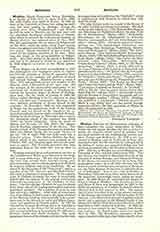

Moulins, Diocese of (Molinensis), suffragan of Sens—comprises the entire department of Allier. Under the old regime Moulins did not even have a parish, the churches which served as parishes were succursal churches of two neighboring country parishes, Yseure and St-Bonnet. In 1788 a see was created at Moulins; and des Gallois de la Tour, who exercised in that city the functions of vicar general to the Bishop of Autun, was appointed bishop, but had not been preconized when the Revolution broke out in 1789. The See of Moulins was reestablished by the Concordat of 1817, and had titulars from 1822. This new diocese was formed of dismembered parts of the Dioceses of Autun, Bourges, and Clermont Ferrand. In this diocese the cantonal districts do not bear their geographical names, as in all other dioceses, but the name of a saint which becomes the patron of the deanery: the Vichy deanery, for instance, is called the deanery of St Raphael. Joan of Arc came to Moulins in November, 1429, and from there wrote letters to all the important surrounding towns, asking for assistance. In 1604 Henry IV authorized the Jesuits to found a college at Moulins. The devotion to the Sacred Heart of Jesus was inaugurated in 1676 at the Visitation monastery of Moulins; St. Jane Frances de Chantal died in this convent in 1641. The monastery of Saint Lieu Sept Fons, in the present territory of the diocese, was founded in 1132 by monks of Cfteaux on a site where there were seven springs (septem fontes) and a sanctuary of the Blessed Virgin; it was reformed in 1663 by Dom Eustache de Beaufort, abbot from 1656 to 1709, a friend of de Rance. In 1845 the monastery was restored by the Trappist Dom Stanislaus Lapierre. St. Benoit Labre passed two months there in 1769. The Benedictine monastery of Souvigny, founded in 916, had a fine Gothic church, where even yet the tombs of many Seigneurs de Bourbon can be seen. Saint Mayeul (Majolus), second abbot of Cluny, died at Souvigny in 994, and St. Odilo, third abbot of Cluny, died there in 1049. The town of Gannat arose about an ancient abbey of Augustinians; the town of St. Pourgain owes its origin to the monastery founded in the sixth century by the slave St. Pourgain (Portianus) who put a stop to the devastations of Thierry, King of Austrasia, during his campaign against Auvergne. The preacher Jean de Lingendes (1595-1665) and the schismatic Abbe Chatel, founder of the “French Catholic Church” (1795-1857), were born in the territory of the present Diocese of Moulins.
The principal pilgrimages of the diocese are: Notre Dame de St. Germain des Fosses; the body of the hermit St. Patroclus (sixth century) at Colombier; the relics of St. Mayeul at Souvigny; and the church of St. George at Bourbon l’Archambault, which possesses one of the largest known fragments of the Holy Cross, a relic given by St. Louis to his son Robert of Clermont. Before the application of the Associations Law of 1901 there were Benedictines, Jesuits, Marists, Lazarists, Redemptorists, Missionary Fathers of the Sacred Heart, and several orders of School Brothers in the Diocese of Moulins. At the beginning of the twentieth century the religious congregations of the diocese had charge of; 1 creche, 15 day nurseries, 2 boys orphanges, 10 girls orphanages, 5 industrial rooms, 1 Magdalen hospital, 6 “houses of mercy” for the care of the sick in their own homes.
In 1908 the Diocese of Moulins counted 390,812 inhabitants, 31 parishes, 281 succursal parishes, 55 vicariates.
GEORGES GOYAU

